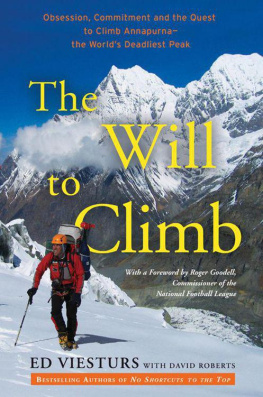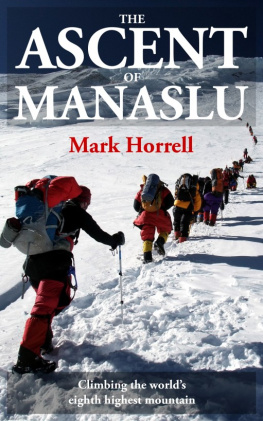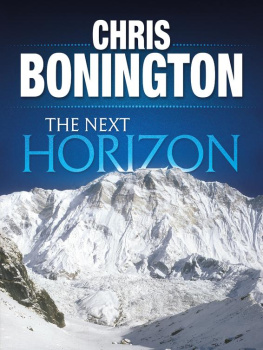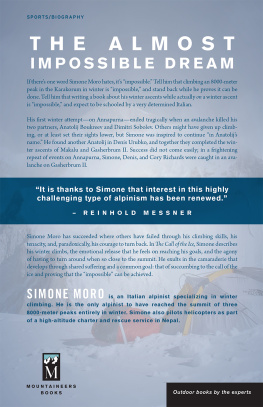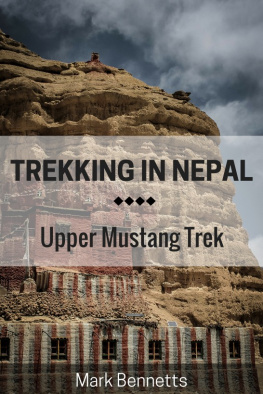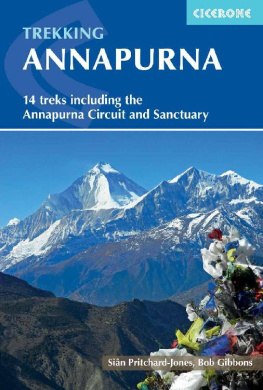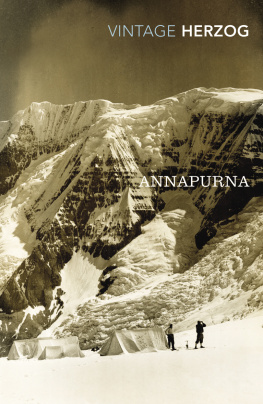A LSO BY THE A UTHOR
No Shortcuts to the Top:
Climbing the Worlds 14 Highest Peaks
K2:
Life and Death on the Worlds Most Dangerous Mountain
Copyright 2011 by Ed Viesturs and David Roberts
All rights reserved.
Published in the United States by Crown Publishers, an imprint of the Crown Publishing Group, a division of Random House, Inc., New York.
www.crownpublishing.com
CROWN and the Crown colophon are registered trademarks of Random House, Inc.
Library of Congress Cataloging-in-Publication Data
Viesturs, Ed.
The will to climb : obsession and commitment and the quest to climb Annapurnathe worlds deadliest peak / Ed Viesturs, with David Roberts.
p. cm.
1. MountaineeringNepalAnnapurna. 2. MountainsNepalAnnapurna
Difficulty of ascent. 3. MountaineersNepalAnnapurna. 4. Annapurna
(Nepal)Description and travel. I. Roberts, David, 1943 II. Title.
GV199.44.N46V54 2011
796.522095496dc22
2011011680
eISBN: 978-0-307-72044-3
Jacket design by Nupoor Gordon
Jacket photograph by Jimmy Chin
v3.1
To my loving wife, Paula, who was with me in my
thoughts and in my heart, step by step, moment by
moment, as I lived my dream of reaching the summit of
Annapurna, my fourteenth 8,000-meter peak.
And to our children, Gilbert, Ella, Anabel, and Nina
our constant source of love, warmth, and entertainment.
Mountains are not stadiums where I satisfy my ambition to
achieve. They are the cathedrals where I practice my religion.
Anatoli Boukreev
There are other Annapurnas in the lives of men.
Maurice Herzog
CONTENTS
Foreword, by Roger Goodell,
Commissioner of the National Football League
FOREWORD
I n July 2009, I found myself climbing Mount Rainier, the huge, snow-covered, 14,411-foot-tall volcano in Washington State, with Ed Viesturs. I wasnt exactly sure what I was doing there, but before our two-day ascent was over, Id realize that getting to the top of that mountain would be the hardest physical, emotional, and mental challenge Id ever faced.
In a sense, Id been sandbagged by Tod Leiweke, the CEO of the Seattle Seahawks at the time. Ed, who lives on Bainbridge Island, just outside of Seattle, is a passionate football fan. Before the 2005 season, Tod and his staff had been brainstorming to find a local celebrity to help connect fans to the Seahawks. Tod had been to one of Eds charitable talks, so he suggested, How about Ed Viesturs?
The upshot was that Ed gave a motivational speech to the Seahawks just before their first game. Later that season, for another game, he was designated the teams Twelfth Man, whose duty is to raise the Seahawks 35-foot-long flag up a pole overlooking one of the end zones at Qwest Field. That was the year the Seahawks made it all the way to the Super Bowl. Ed had arranged for all the players to receive miniature carabinersdevices symbolizing the teamwork of climbers roped togetherafter each victory. After the contest that clinched the NFC West division title, the team gave Ed the game ball. After the Super Bowl, the Seahawks also gave Ed an NFL Championship team ring.
The relationship between mountaineer and football team resulted in Eds guiding Tod up Mount Rainier in the summer of 2008. And though he found the climb a stern challenge, Tod decided to repeat it the following summer with a new cast of characters as a fund-raising event for a local charity, the United Way of King County. Tod had talked Jim Mora, the Seahawks head coach at the time, into joining the team. Then, one day as I was about to start a league meeting in Dallas, Tod said, Roger, one quick question. Will you climb Rainier with us to help our local United Way?
Sure, no problem, I answered, then turned my attention to the meeting.
It was only sometime later that I took stock and thought, What did I just do? Id never climbed so much as a big hill before, but Id certainly seen Rainier rearing its massive bulk nearly three vertical miles above Seattle in the southeast. Nevertheless, I was determined to go through with it.
In early July, we all met at Paradise, the trailhead for Rainier. Besides Mora, Leiweke, and me, there were several local community leaders and four professional guides led by Ed and Peter Whittaker, co-owner of Rainier Mountaineering, Inc. It was as a guide for RMI that Ed got his start as a climber in his early twenties. By July 2009, hed climbed the mountain a remarkable 203 times! Rainier was obviously a piece of cake for Ed. In 2005, hed become the first American to climb the fourteen highest mountains in the worldall without bottled oxygen. Hes still the only American whos pulled off that feat. And just two months before our rendezvous at Paradise, hed climbed Mount Everest for the seventh time.
I trained for the climb by running in my neighborhood with a loaded backpack and jogging up stairwells in New York City, carrying weights in each hand, but nothing prepares you for altitude. Ed and Peter put us through our paces, training us on how to carry our ice axes, how to self-arrest with them if we slipped and fell, even how to walk on snow in a way that minimized our exertion. I survived this initial challenge, although one of my fellow climbers dislocated his elbow.
The first day we went from Paradise, at 5,400 feet, to Camp Muir, at 10,000. Its a grueling ascent, but essentially just a hike. The real climbing starts above Muir. That night we slept in prefab huts and planned to get up shortly after midnight to set out for the summit well before dawn. Ed and Peter had stressed over and over again the importance of keeping hydrated; I think I drank almost two gallons of water that evening. That meant I had to get up frequently during the night, clamber down from my third-tier bunk, put on all my clothes, and go outside to relieve myself. Even in the dark, the view was stunning. I could see other giant mountains in the distance, including Baker, Adams, and Saint Helens. After a while I gave up trying to sleep; Coach Mora and I just stayed up and stared at the magnificent vistas before us.
A cameraman whod joined our team to shoot the climb for NFL Films caught my exchange with Peter Whittaker at twelve thirty A.M . on summit day. Peter asks me, Roger, how do you feel? I answer, I feel good. Zero sleep. What I remember saying, however (and what must have been cut out of the film), was, I feel like crap; why do you care?
We took off by two thirty, roped close together in groups of four with our guides in the lead. For the first time in my life, I was wearing the metal spikes attached to my boots that climbers call crampons. I was feeling a combination of anxiety and confidence. I would have been happy to start even earlierI wanted to get going.
As we started up, I thought, This is like playing golf with Tiger Woods your first time on a course. Im definitely out of my league.
Yet I was moving along pretty well until we suddenly bumped into a crevasse that ran smack across our path. One thing Ive got to chide Ed and Peter for is that during our training they told us all about the dangers of avalanches, falling rocks, and altitude sickness. Peter almost morbidly described the 1981 accident when a collapsing ice cliff snuffed out the lives of eleven climbers at a place right on our ascent route. (Im not sure I needed to hear that little story.) But they never said a word about crevasses.
Next page
